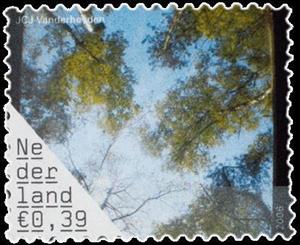Stamp: J.C.J. Vanderheyden (Netherlands 2006)
J.C.J. Vanderheyden (Netherlands 2006)
02 January (Netherlands ) within release Art goes into circulation Stamp J.C.J. Vanderheyden face value 0.39 Euro
| Stamp J.C.J. Vanderheyden in catalogues | |
|---|---|
| Michel: | Mi:NL 2376 |
| NVPH: | NVP:NL 2399 |
Stamp is horizontal format.
self adhesiveAlso in the issue Art:
- Stamp - Atelier Van Lieshout, 2000 face value 0.39;
- Stamp - Sigurdur Gudmundsson (1979) face value 0.69;
- Stamp - Jeff Wall (2002) face value 0.69;
- Stamp - Daniel Buren (1988) face value 0.69;
- Stamp - Fat (2005) face value 0.69;
- Stamp - Olafur Eliasson (2000) face value 0.69;
- Stamp - Dustin Larson (2003) face value 0.85;
- Stamp - Tadashi Kawamata (1996/2004) face value 0.85;
- Stamp - Ed van der Elsken, 1975 face value 0.39;
- Stamp - "Double Dutch" by Berend Strik (2000) face value 0.39;
- Stamp - Hans van der Meer, 1998 face value 0.39;
- Stamp - Marijke van Warmerdam, 2004 face value 0.39;
- Stamp - Barbara Visser, 2001 face value 0.39;
- Stamp - Daan van Golden, 1964 face value 0.39;
- Stamp - J.C.J. Vanderheyden face value 0.39;
- Stamp - Marinus Boezem, 1987 face value 0.39;
- Stamp - John Körmeling, 1988 face value 0.39;
- Stamp - Sean Snyder (2003) face value 0.85;
- Stamp - Pica (2004) face value 0.85;
- Stamp - Rosemarie Trockel (1988) face value 0.85;
Stamp J.C.J. Vanderheyden it reflects the thematic directions:
In botany, a tree is a perennial plant with an elongated stem, or trunk, supporting branches and leaves in most species. In some usages, the definition of a tree may be narrower, including only woody plants with secondary growth, plants that are usable as lumber or plants above a specified height. Trees are not a taxonomic group but include a variety of plant species that have independently evolved a woody trunk and branches as a way to tower above other plants to compete for sunlight. In looser senses, the taller palms, the tree ferns, bananas and bamboos are also trees. Trees tend to be long-lived, some reaching several thousand years old. The tallest known tree, a coast redwood named Hyperion, stands 115.6 m (379 ft) high. Trees have been in existence for 370 million years. It is estimated that there are just over 3 trillion mature trees in the world. A tree typically has many secondary branches supported clear of the ground by the trunk. This trunk typically contains woody tissue for strength, and vascular tissue to carry materials from one part of the tree to another. For most trees it is surrounded by a layer of bark which serves as a protective barrier. Below the ground, the roots branch and spread out widely; they serve to anchor the tree and extract moisture and nutrients from the soil. Above ground, the branches divide into smaller branches and shoots. The shoots typically bear leaves, which capture light energy and convert it into sugars by photosynthesis, providing the food for the tree's growth and development. Flowers and fruit may also be present, but some trees, such as conifers, instead have pollen cones and seed cones; others, such as tree ferns, produce spores instead. Trees play a significant role in reducing erosion and moderating the climate. They remove carbon dioxide from the atmosphere and store large quantities of carbon in their tissues. Trees and forests provide a habitat for many species of animals and plants. Tropical rainforests are one of the most biodiverse habitats in the world. Trees provide shade and shelter, timber for construction, fuel for cooking and heating, and fruit for food as well as having many other uses. In parts of the world, forests are shrinking as trees are cleared to increase the amount of land available for agriculture. Because of their longevity and usefulness, trees have always been revered, with sacred groves in various cultures, and they play a role in many of the world's mythologies.
A photographer (the Greek φῶς (phos), meaning "light", and γραφή (graphê), meaning "drawing, writing", together meaning "drawing with light") is a person who uses a camera to make photographs.
Art is a diverse range of human activities in creating visual, auditory or performing artifacts (artworks), expressing the author's imaginative or technical skill, intended to be appreciated for their beauty or emotional power. In their most general form these activities include the production of works of art, the criticism of art, the study of the history of art, and the aesthetic dissemination of art. The oldest documented forms of art are visual arts, which include creation of images or objects in fields including painting, sculpture, printmaking, photography, and other visual media. Architecture is often included as one of the visual arts; however, like the decorative arts, or advertising, it involves the creation of objects where the practical considerations of use are essential—in a way that they usually are not in a painting, for example. Music, theatre, film, dance, and other performing arts, as well as literature and other media such as interactive media, are included in a broader definition of art or the arts. Until the 17th century, art referred to any skill or mastery and was not differentiated from crafts or sciences. In modern usage after the 17th century, where aesthetic considerations are paramount, the fine arts are separated and distinguished from acquired skills in general, such as the decorative or applied arts.
Flora is the plant life occurring in a particular region or time, generally the naturally occurring or indigenous—native plant life. The corresponding term for animal life is fauna. Flora, fauna and other forms of life such as fungi are collectively referred to as biota. Sometimes bacteria and fungi are also referred to as flora, as in the terms gut flora or skin flora.




